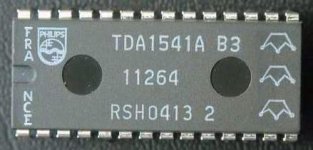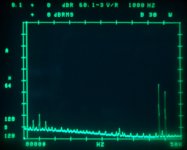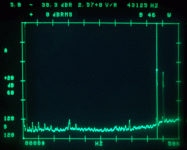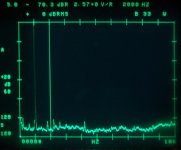You may have noticed the till teorema: the more THD the more audiophile. Using a chip like that will prevend me from spending hundreds of hours searching for a little more of 7th harmonic by swapping resistors, expensive electrolytics, or adding ferrite or maybe even real pearls in the digital grounding....
🙂 🙂 🙂till said:You may have noticed the till teorema: the more THD the more audiophile. Using a chip like that will prevend me from spending hundreds of hours searching for a little more of 7th harmonic by swapping resistors, expensive electrolytics, or adding ferrite or maybe even real pearls in the digital grounding....
Please send 2 of them to me too.
😎
till said:You may have noticed the till teorema: the more THD the more audiophile. Using a chip like that will prevend me from spending hundreds of hours searching for a little more of 7th harmonic by swapping resistors, expensive electrolytics, or adding ferrite or maybe even real pearls in the digital grounding....
I've got an easier solution: just stop DIY and duy commercial stuff 😀
I've got an easier solution: just stop DIY and duy commercial stuff
I never did and will no do. I have a problem concerning what we call "Produktästhetik" with commercial elektronics. The only products of the consumer range of electronic/electric devices i buy are tools : Hilti, Fein, Flex/porter cable... and of corse computer parts if absolutely necessary.
btw: i would suspect the specs of commercial gear are very good. Same as compare gainclone THD to aleph THD...
jean-paul said:Stamp them B1 😉
This joke is real stupid.
-51 and -56 are average values for harmonics in non os mode with 1kHz -60dB signal.
Nothing bad.
Bad is -47, good is -64.
Bricolo said:Why only B1? 😉
This chip must be
M
a
d
e
i
n
F
r
a
n
c
e
!
😀
Attachments
But why do you test them with a -60dB signal? Wouldn't full scale, or at least half scale, be more appropriate?
For the chip, it wasn't written made in taiwan but only taiwan, do france would also be enough 😉
For the chip, it wasn't written made in taiwan but only taiwan, do france would also be enough 😉
Back to serious for those who are interested
Todays work so far:
Tested 5 chips like a, b, c, d, e, f (only one channel).
Then tested 6 combinations of two chips parallel, like a&b, c&f, b&d ...
Distortion is random, everything is possible.
The result of throwing two chips together is unpredictable.
If the two chips have values -50 & -54, the result could be:
-48, -50, -52, -54, or -56, but mostly it will be in the middle like -52.
In my test it was better than each single chip 9x, like the better chip 2x, in the middle 17x, like the inferior chip 3x, worse than each single chip 5x.
With lots of chips, good combinations can be found.
Todays work so far:
Tested 5 chips like a, b, c, d, e, f (only one channel).
Then tested 6 combinations of two chips parallel, like a&b, c&f, b&d ...
Distortion is random, everything is possible.
The result of throwing two chips together is unpredictable.
If the two chips have values -50 & -54, the result could be:
-48, -50, -52, -54, or -56, but mostly it will be in the middle like -52.
In my test it was better than each single chip 9x, like the better chip 2x, in the middle 17x, like the inferior chip 3x, worse than each single chip 5x.
With lots of chips, good combinations can be found.
Bricolo said:But why do you test them with a -60dB signal? Wouldn't full scale, or at least half scale, be more appropriate?
The analyzer can only see down to it's noise floor of -75dB.
With full scale signal it will not see much, because THD of the TDA is very low, like -90.
With the -60dB signal THD of the TDA goes up, to -40.
So it gets visible for the analyzer.
Philips used -60dB signal for selection too.
If you have the time, could you just show is the spectrum of a non os player, at a normal volume?
Just to see how big the 44kHz noise is
Just to see how big the 44kHz noise is
Yes, you already posted this
what I wanted to see is the amplitude of the 44khz compares to a full scale signal
what I wanted to see is the amplitude of the 44khz compares to a full scale signal
Bricolo said:Yes, you already posted this
what I wanted to see is the amplitude of the 44khz compares to a full scale signal
Yeah, send me a bottle of good french wine and I will see what I can do

Remember, this was with the analog filter that is inside the CD650, I did not remove it.
TDA1540 said:bernhard,
do you mean the extra filterpcb?
No, the filter for the 176kHz that comes after the I/V converter.
Bricolo said:I'll only trade a bottle of wine for a genuine S1 😉
Keep your bottle and I keep my S1 😀
This is 0dB signal. Again 44kHz is -38dB.
It is displayed in the upper left corner
So it is proportional to the signal level.
Attachments
Bernhard said:
So it is proportional to the signal level.
That's what I was fearing 🙁
And this is with your player's analog filter? If you didn't modify it, I don't think it changes something, since it was certainly designed to attenuate the 4*Fs garbage
thank you for the measurements!
hey Bricolo, you just safed one bottle of wine. Send it to me!
If you send together with 2 of the famous B3 it will also safe some shipping costs.
If you send together with 2 of the famous B3 it will also safe some shipping costs.
till said:hey Bricolo, you just safed one bottle of wine. Send it to me!
If you send together with 2 of the famous B3 it will also safe some shipping costs.
Those B3 are hand made, and it takes a lot of time 😀
Bricolo said:But why do you test them with a -60dB signal? Wouldn't full scale, or at least half scale, be more appropriate?
For the chip, it wasn't written made in taiwan but only taiwan, do france would also be enough 😉
Not much harmonics to see with a 0dB signal. Just some garbage.
Bricolo said:That's what I was fearing 🙁
That's what is called amplitude modulation

Attachments
- Status
- Not open for further replies.
- Home
- Source & Line
- Digital Source
- 1541 / 1543 wake up !



